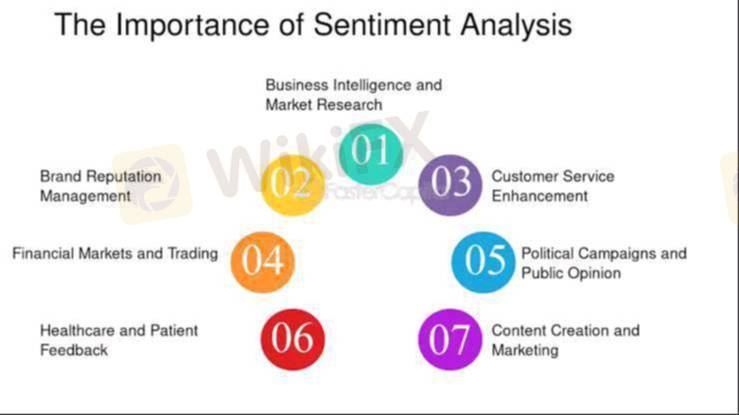
2025-02-17 22:01
IndustriThe role of sentiment analysis in risk mitigation.
#forexrisktip
Sentiment analysis plays a crucial role in risk mitigation by allowing organizations to understand and respond to public sentiment about their brand, products, or services. Here's how it works:
1. Identifying Potential Risks:
* Early Warning System: By monitoring social media, news articles, and other online platforms, sentiment analysis tools can detect emerging negative trends or opinions that could escalate into a crisis.
* Cybersecurity Threats: Sentiment analysis can be used to identify potential cyber threats by analyzing emotional tones in online discussions, social media, and communications. This can help organizations detect and prevent cyberattacks.
* Brand Reputation: Sentiment analysis can help organizations understand how their brand is perceived by the public. This information can be used to mitigate risks to brand reputation.
2. Proactive Mitigation:
* Address Issues Promptly: Once a potential risk is identified, organizations can take proactive steps to address the issue before it escalates. This might involve responding to negative feedback, issuing a public statement, or taking corrective action.
* Improve Customer Experience: By understanding customer sentiment, organizations can identify areas where they can improve the customer experience and reduce the risk of negative feedback.
3. Crisis Management:
* Monitor Public Reaction: During a crisis, sentiment analysis can be used to monitor public reaction and understand how the situation is being perceived. This information can be used to inform crisis communication strategies.
* Measure the Effectiveness of Responses: Sentiment analysis can be used to measure the effectiveness of crisis response strategies and make adjustments as needed.
Examples of Sentiment Analysis in Risk Mitigation:
* A company detects a spike in negative sentiment on social media about a new product. They investigate the issue and find that customers are unhappy with a specific feature. The company can then take steps to address the issue, such as releasing a software update or offering refunds.
* A financial institution uses sentiment analysis to monitor news articles and social media for mentions of potential risks to the financial system. This information can be used to inform risk management strategies.
* A government agency uses sentiment analysis to monitor public opinion about a new policy. This information can be used to identify potential areas of concern and make adjustments to the policy.
By using sentiment analysis effectively, organizations can identify and mitigate risks before they cause significant damage to their brand, reputation, or bottom line.
Suka 0
FX2409028569
Trader
Diskusi populer
Industri
СЕКРЕТ ЖЕНСКОГО ФОРЕКСА
Industri
УКРАИНА СОБИРАЕТСЯ СТАТЬ ЛИДЕРОМ НА РЫНКЕ NFT
Industri
Alasan Investasi Bodong Tumbuh Subur di Indonesia
Industri
Forex Eropa EURUSD 29 Maret: Berusaha Naik dari Terendah 4 Bulan
Analisis pasar
Bursa Asia Kebakaran, Eh... IHSG Ikut-ikutan
Analisis pasar
Kinerja BUMN Karya Disinggung Dahlan Iskan, Sahamnya Pada Rontok
Klasifikasi pasar

Platform

Pameran

Agen

Perekrutan

EA

Industri

Pasar

Indeks
The role of sentiment analysis in risk mitigation.
 India | 2025-02-17 22:01
India | 2025-02-17 22:01#forexrisktip
Sentiment analysis plays a crucial role in risk mitigation by allowing organizations to understand and respond to public sentiment about their brand, products, or services. Here's how it works:
1. Identifying Potential Risks:
* Early Warning System: By monitoring social media, news articles, and other online platforms, sentiment analysis tools can detect emerging negative trends or opinions that could escalate into a crisis.
* Cybersecurity Threats: Sentiment analysis can be used to identify potential cyber threats by analyzing emotional tones in online discussions, social media, and communications. This can help organizations detect and prevent cyberattacks.
* Brand Reputation: Sentiment analysis can help organizations understand how their brand is perceived by the public. This information can be used to mitigate risks to brand reputation.
2. Proactive Mitigation:
* Address Issues Promptly: Once a potential risk is identified, organizations can take proactive steps to address the issue before it escalates. This might involve responding to negative feedback, issuing a public statement, or taking corrective action.
* Improve Customer Experience: By understanding customer sentiment, organizations can identify areas where they can improve the customer experience and reduce the risk of negative feedback.
3. Crisis Management:
* Monitor Public Reaction: During a crisis, sentiment analysis can be used to monitor public reaction and understand how the situation is being perceived. This information can be used to inform crisis communication strategies.
* Measure the Effectiveness of Responses: Sentiment analysis can be used to measure the effectiveness of crisis response strategies and make adjustments as needed.
Examples of Sentiment Analysis in Risk Mitigation:
* A company detects a spike in negative sentiment on social media about a new product. They investigate the issue and find that customers are unhappy with a specific feature. The company can then take steps to address the issue, such as releasing a software update or offering refunds.
* A financial institution uses sentiment analysis to monitor news articles and social media for mentions of potential risks to the financial system. This information can be used to inform risk management strategies.
* A government agency uses sentiment analysis to monitor public opinion about a new policy. This information can be used to identify potential areas of concern and make adjustments to the policy.
By using sentiment analysis effectively, organizations can identify and mitigate risks before they cause significant damage to their brand, reputation, or bottom line.
Suka 0
Saya juga ingin komentar
Tanyakan pertanyaan
0Komentar

Belum ada yang berkomentar, segera jadi yang pertama

Tanyakan pertanyaan
Belum ada yang berkomentar, segera jadi yang pertama